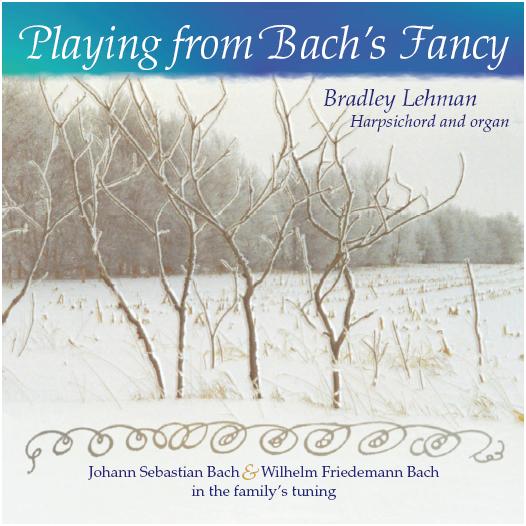 LaripS.com, © Bradley Lehman, 2005-22, all rights reserved. All musical/historical analysis here on the LaripS.com web site is the personal opinion of the author, as a researcher of historical temperaments and a performer of Bach's music.
The mathematics of fifths and major thirds, modeled in modern Temperament Units and in Sorge's 18th century discussion of schismas
Mathematisches Opfer
All keyboard temperaments can be described and modeled conveniently with the system of "Temperament Units" devised by organ-builder John Brombaugh (1980s-90s). This is a useful logarithmic system that delivers a clearer conceptual picture of the issues, compared with the more familiar logarithmic system of "cents" (19th century, Ellis, with equal temperament as the standard). As introduction, here is an excerpt from my older web page about general issues of tuning:
In short: we chop the "Pythagorean Comma" (also called "Ditonic Comma") up into 720 equal portions, geometrically. Logarithmic schemes can be set up on any arbitrary number, whatever is most convenient. Brombaugh picked 720 because it simplifies all the typical operations that temperaments have, such as dividing that comma (or the competing 660 "Syntonic Comma") easily by 1, 2, 3, 4, 5, 6, and 12. It turns everything into Diophantine (integer) arithmetic/geometry. This is a logarithmic scheme, so our multiplications and divisions turn into simpler addition and subtraction. We can figure out the size of any interval by adding up these little units to get from one note to the next. And the units themselves are small enough that we never have to go down to fractions or decimals of units, as happens in the much coarser "cents" method throughout the standard tuning literature. (Arbitrarily, the size of an equal-tempered semitone is 100 cents. The size of a "cent" is picked so it works out that way.) "91.73 cents" in the tuning of some interval? C'mon, just pick a smaller unit for the logarithms so we're never dealing with decimals! That's the point of this alternative TU method. The familiar "cent" of 2^(1/1200) is much too big for our present purposes. Conversion: because a Pythagorean Comma is approximately 23.46001038 cents, and we're chopping that amount into 720 little bits, each TU is approximately 0.0325833478 cents. With the reciprocal of that, each cent is approximately 30.6905235 Temperament Units. Anything can be measured elegantly if one first picks a useful unit to simplify the numbers! (For background on the basic operations of logarithms, consult standard mathematics textbooks. Introduction to the Pythagorean and syntonic commas, the schisma, and the diesis is available in the first half of my Early Music article, or my older web page, or the standard tuning literature.)
An example: Werckmeister 3The recipe for the familiar "Werckmeister 3", expressed in Temperament Units, is:
F 0 C -180 G -180 D -180 A 0 E 0 B -180 F# 0 C# 0 G# 0 D# 0 A# 0 F As is obvious, the entire row adds up to -720 as it must do (in all twelve-note temperaments). The total of one Pythagorean Comma (720) is removed from the set of twelve fifths. Eight of those fifths, in this example, are pure; and the other four each have 1/4 of the remainder. Therefore, each of the fifths C-G, G-D, D-A, and B-F# are tempered by "1/4 Pythagorean Comma". How are the major thirds? To find the quality of any particular major third, we add up the four TU amounts of its component fifths. Then we add 660 (one Syntonic Comma) and divide by 660, to find the fraction of a Syntonic Comma that the major third interval is sharp of pure. (That is, how much wider it is than an interval formed by two pitches whose frequencies are in 5:4 ratio, a "pure major third".)
Equal temperamentIn equal temperament the recipe is trivial:
F -60 C -60 G -60 D -60 A -60 E -60 B -60 F# -60 C# -60 G# -60 D# -60 A# -60 FAll the major thirds are 63.6% sharp: (660 -240)/660.
Bach's temperamentNow a look at Bach's, using this same analytical scheme.
 F -120 C -120 G -120 D -120 A -120 E 0 B 0 F# 0 C# -60 G# -60 D# -60 A# +60 F The first eleven fifths are determined by Bach's diagram, where the unit for each little "bobble" in his loops is -60 (by the present system of measurement). The whole line must add up to -720, our truism. Therefore the remaining fifth (really a diminished sixth), A#-F, is the resulting wide +60. How are the major thirds?
This gives it remarkable variety during sequences of tonal music, for example going from A major to D major to G major to C major in musical modulation. These triads change in perceptible quality, due to the different sizes of those major thirds in there. The music "relaxes" as that major-third error diminishes, or "increases in tension" as it increases up toward the E major area, giving a "bright" effect. (These words are of course subjective descriptions, but the phenomenon itself is measureable. That is the point here.) Sparschuh-ZapfThe informally proposed Zapf temperament of early 2001 (revising Sparschuh of the late 1990s) interprets the loops of Bach's diagram as arithmetic beat rates, producing ten different sizes of fifths. That is, all the beat rates in a particular octave (and at a particular starting-fork pitch) are forced to be either once per second, once per two seconds, pure, or a residual 0.9. It comes out like this:
F -96 C -142 G -95 D -127 A 0 E 0 B 0 F# -50 C# -67 G# -44 D# -60 A# -40 F The major thirds:
That's why I believe that this type of layout, holding beat rates constant instead of fifth-sizes, has nothing to do with practical 18th century musicianship. It's simply an interesting modern temperament for solo keyboard use, based on an ahistoric mathematical premise about equal-beating. Its formulation (claimed to be a Bach temperament) doesn't treat Bach's handwritten letter C as part of the evidence, and it inserts the premise that Bach either didn't know or didn't care about normal regularity of naturals for ensemble use. The resulting layout makes a seductive sound for fully-chromatic music, mainly because it has no major thirds as much as 100% comma out of tune. That is, it sounds smoother than most of its competitors (such as the "Vallotti", Werckmeister, and regular meantone temperaments familiar to Baroque-keyboard specialists), due to some of its properties that are mathematical truisms.
Handling the diesis in analysis of temperamentsA visual model (as an exercise for the reader): draw a circle and label it like a clock face, with C at 12 o'clock, G at 1 o'clock, D at 2 o'clock, etc around to F at 11 o'clock. Between these labels write in the TU value for that fifth. The major thirds can then be observed by drawing chords (line segments) cutting across the circle to join the note names.Each group of three major thirds then forms a triangle. For example, C to E, E to G#, and G# (Ab) to C. Each such triangle looks equilateral on paper, in such a drawing; but in the musical intervals those distances may be different sizes! In each triangle, the three major thirds must add up to -1260, the diesis. That is two syntonic commas (660 each) less a schisma (60, the difference between the Pythagorean Comma and the Syntonic Comma). In Bach's temperament, C to E is -180, E to G# is -600, and G# to C is -480. Total, -1260. Likewise it can be shown that the three other triangles also add up to -1260 each, and each having different proportions as to the distribution within that -1260.
Sorge's (and Neidhardt's) 18th century model of 21 schismas in a diesisGeorg Andreas Sorge (who had been Bach's colleague in the Mizler society) knew about this in the 1770s, not using Temperament Units but doing equivalent work geometrically. And, it is in the literature as early as Neidhardt's Sectio Canonis of 1724: where he had a table showing all twelve of the major thirds and all twelve of the minor thirds. Such a table shows the number of schismas that each of the intervals is sharp or flat. (See a facsimile of one of the pages at p266 in Lindley's Stimmung und Temperatur; the fuller citation is below. Neidhardt reckoned each set of three major 3rds to a total of 24 units; Sorge refined this later to 21 units.) The -1260 of a diesis is 21 schismas, 21 * -60. All these triangles of three stacked major thirds must add up to 21 schismas. Keyboard temperaments can then be expressed, elegantly, as four ordered triples! For example, Bach's is C(3, 10, 8), F(3, 9, 9), Bb(6, 7, 8), Eb(7, 5, 9).That is: C to E is 3, E to G# is 10, and Ab to C is 8; These can be seen reading up from the bottom of the charts at this mathematical analysis page. As this exercise shows, "Werckmeister 3" can be expressed as: C(2, 8, 11), F(2, 8, 11), Bb(5, 5, 11), Eb(8, 5, 8). Equal temperament is the trivial matrix: C(7, 7, 7), F(7, 7, 7), Bb(7, 7, 7), Eb(7, 7, 7). Sparschuh-Zapf: C(4.933, 9.05, 7), F(3.35, 10.17, 7.483), Bb(4.8, 8.883, 7.317), A chart comparing other ordered triples in this manner is available from Oxford's web site along with the other Appendix material for my article. I have also put these into this cube puzzle layout illustrating the issues to be solved in keyboard temperaments. For further reading about the Neidhardt/Sorge scheme of 21 portions to the diesis:
Other applicationsThe set of twelve major-third measurements for any temperament can be graphed to deliver a wavelike shape associated with that temperament. This is left as an exercise for the reader. Equal temperament's graph is of course a straight horizontal line....Similarly, it is an important exercise to set up various temperaments on suitable instruments (harpsichords, organs, pianos, synthesizers) and then play through all the resulting major thirds, to become familiar with the temperament's shape in the sound. Some practical tuning instructions are available here and elsewhere in the standard tuning literature. Music is just a bunch of applied mathematics, right? And vice versa?
AvailabilityMy Temperament Unit analyses for more than forty competing temperaments are available as supplementary downloads from Oxford's web site. These accompany an Appendix to the February portion of my article.See also a summary of these recipes.  |
v Introduction v Articles v FAQ v Practice > Theory - Measurements - Comparisons - Other "Bach" - [Extra]ordinary - Regular/Mean - Enharmonics - Cube puzzle - Geometric 5ths * TU & Schismas - Fa Ti Modulation v History v Etc v Recordings |


